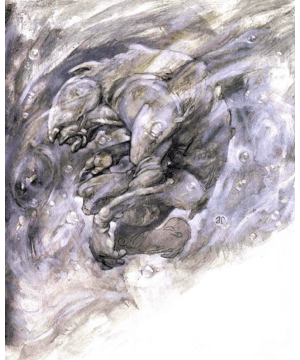

2635

| Climate/Terrain: | Inner Planes |
|---|---|
| Frequency: | Very rare |
| Organization: | Solitiary |
| Activity Cycle: | Any |
| Diet: | None |
| Intelligence: | High to genius (14-17) |
| Treasure: | Nil |
| Alignment: | Neutral |
| No. Appearing: | 1 |
| Armor Class: | -4 |
| Movement: | 18 |
| Hit Dice: | 9 |
| THAC0: | 11 |
| No. of Attacks: | 1 |
| Damage/Attack: | 2d4+4 |
| Special Attacks: | Disintegration |
| Special Defenses: | Struck only by +1 or better weapons, immune to elemental attacks |
| Magic Resistance: | 45% |
| Size: | L (10’ tall) |
| Morale: | Champion (20) |
| XP Value: | 8,000 |
The Outer Planes and the Inner Planes differ in many, many ways. One of the most striking differences is that on the Inner Planes, it’s possible for a body to walk (or swim, or whatever) from one plane to another. While each plane is infinite, it also borders many of the other planes. Some theorize that all of the Inner Planes border all of the others, and that not all the borders have been discovered. Most graybeards think, however, that only certain planes border others. (See the diagram/map in the Planescape Campaign Setting boxed set.)
The places where one plane fades into another are strange indeed. The conditions of one environment begin to subtly change until, before a body has tumbled to it, he’s crossed over into the neighboring plane. Well, these strange areas have spawned a strange inhabitant. This creature, found only in places where two Inner Planes meet, is the menglis.
An elemental spirit unlike any other, the menglis is born of opposition. In those places where fundamental concepts and conditions clash, the menglis thrives. It is essentially invisible, but if a body’s able to see those things that others can’t, he’ll see the menglis as a 10-foot-tall humanoid spirit, colorless and somewhat amorphous. While the menglis is not overly hostile, it’s dangerous nonetheless.
Solitary beings, the menglis do not have their own language but can communicate with other creatures through telepathy.
Combat: Menglis are not aggressive or predatory creatures. Nonetheless, a canny planewalker takes steps to avoid the spirits, because their mere presence can cause a body great harm.
The menglis has the ability to separate an object into its component elements. Fact is, anything within 30 feet of the creature is rendered into its most basic compounds. Beings must make a saving throw versus petrification to resist the deadly power. If a sod fails the saving throw, his body turns into elemental substances in 2d6 rounds. As each round of this transformation passes, the victim surfers 2d8 points of damage. This process can be halted only by one of the following spells: cure disease, heal, the various hold spells, or a remove curse appropriate to the creature. Damage inflicted by the partial transformation must then be healed normally.
All objects, including any equipment a character might have, must also make a saving throw (versus disintegration) to avoid being broken down into their basic elements. A spear’s metal head, for example, would change into bits of stone and minerals, while the wooden shaft would melt into water after giving off a brief burst of positive energy. Objects break down more quickly than living beings; the process takes only 1d4 rounds. An item, mend, or remove curse spell halts and even reverses the process, but only if cast before the object has completely disintegrated. The disintegration can also be stopped by leaving the menglis’ area of effect.
Once a creature or object has made a successful saving throw versus this effect, no further saving throws versus that particular menglis’ power are required for the rest of that day.
’Course, the death of the menglis also halts the transformation process. Because of this, it has learned to defend itself against attackers. It can lash out with a savage corporeal blow, inflicting 2d4+4 points of damage. For the most part, however, it is a noncorporeal spirit, difficult to harm. It is immune to nonmagical weapons (+1 or better to hit), and no elemental-based magic or attack can affect it.
The menglis can “turn off” the disintegration effect if it so wishes (to talk with other creatures, for example). However, this requires great concentration and the mengis can’t repress the effect for long. In any case, it rarely has reason to do so.
Habitat/Society: Aside from the borders between two planes, menglis can also be found (albeit rarely) in places where one element is incongruously found within another, such as the rare pockets of air within the plane of Earth or the odd clouds of steam a body might find on the plane of Fire. No one has ever seen two or more of these creatures together. They have no society or association. Each menglis lives alone within an elemental border zone, somehow sustained by the transition of one element to another. Yet they are also prisoners of their own environments, for they cannot leave the in-between areas of the planes. If a menglis is somehow forced out of the area it inhabits, or if the area is somehow altered or destroyed so that there is no transition, the creature ceases to be.
Ecology: Menglis do not feed, breed, or willingly interact with other beings in any way. However, the new threat of the entropes to the menglis’ essential environment may drive them to contact other beings to stop the entropes’ ravages.
Last Modified: September 02, 2009, 13:58:10 GMT

◆ 1259 ◆